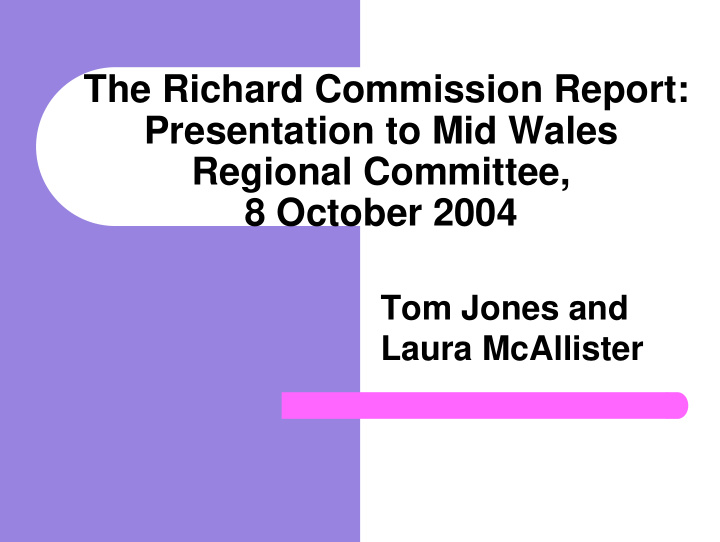



The Richard Commission Report: Presentation to Mid Wales Regional Committee, 8 October 2004 Tom Jones and Laura McAllister
Aims of presentation � To provide an overview of report and its recommendations. � To explain what we tried to do, how we approached the task, and why we reached our specific recommendations.
Beyond the Terms of Reference Two prescribed areas: � Powers � Electoral Arrangements � Broadly interpreted - independent � commission Opened up other critical areas � Designing overall framework for good � governance
Methodology and Approach � Practical focus, not overly technocratic, public’s views paramount � “Critically evidential”! � Test against own “vision” � Integrated approach to Terms of Reference � Aims: – holistic blueprint for improvements – maximalist coverage and sustainable governance
The Vision “The Assembly is the democratically elected representative body for the whole of Wales. The WAG should be able to formulate policies within clearly defined fields, and should have the power to implement all the stages for effective delivery, in partnership with the UK Government and other stakeholders. The Assembly should be able to set its own priorities and timetables for action. It should be accountable to the people of Wales through the elected Assembly for its policies and their implementation.”
Basis for Recommendations � Best sustainable solution for Wales (not for WAG, National Assembly or political parties) � Underpinning principles: fair representation, good governance, democratic legitimacy and public support � Contribution to improved public engagement with Assembly, plus job satisfaction for politicians and officials alike
“A Virtual Parliament”: the Evolution of Devolution � WAG and the National Assembly � Creation and re-naming of Parliamentary Service with separate budget � Separation of staff protocols, free-standing legal advice, House Committee, Executive Board (with special advisers), new policy focus � Less of a dichotomy between executive and legislative devolution � Permissive legislative powers � Operation of plenary and Subject Committees
Stretch or Strain?: A Creaking Internal Architecture � Corporate body has had its day � Too few members? � Under resourced Parliamentary Service � Trade offs between policy development and effective scrutiny- SCs and Plenary � Some under-used capacity? Better use of timetable but still needs more AMs
The Key Recommendations � A legislative Assembly for Wales � Test framework delegated powers approach in meantime � End of corporate body � 20 extra members � Elected by STV � Changes in place by 2011, or sooner
A report with a long shelf life � Outcome is crucial, but process itself is very important � Not about hasty reactions: durability of report � Up to the people of Wales- referendum and campaigning more widely
Concluding Remarks � Serious contribution to an often immature debate � Strikes right balance between ambition and realism � Unlikely to be another Richard Commission � Therefore, premium on sustainability, clarity, workability, accountability � Not another muddled compromise � We’ve done our bit - over to others to push for its implementation
The Vision “The Assembly is the democratically elected representative body for the whole of Wales. The WAG should be able to formulate policies within clearly defined fields, and should have the power to implement all the stages for effective delivery, in partnership with the UK Government and other stakeholders. The Assembly should be able to set its own priorities and timetables for action. It should be accountable to the people of Wales through the elected Assembly for its policies and their implementation.”
Recommend
More recommend